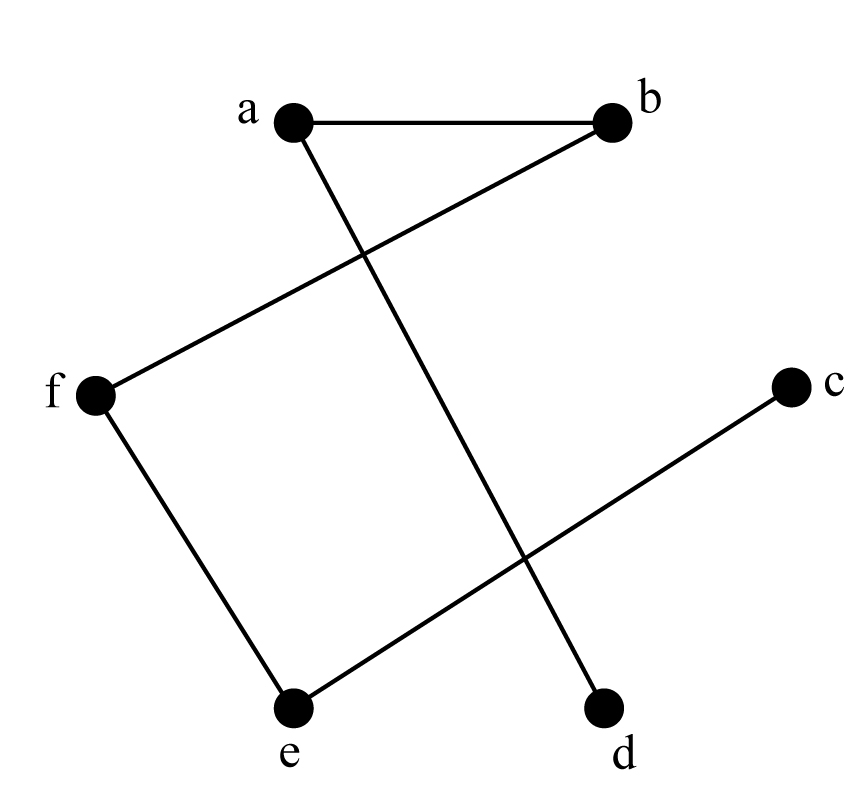5 (i)
Advanced Engineering Mathematics
10th Edition
ISBN:9780470458365
Author:Erwin Kreyszig
Publisher:Erwin Kreyszig
Chapter2: Second-order Linear Odes
Section: Chapter Questions
Problem 1RQ
Related questions
Topic Video
Question

Transcribed Image Text:(a) Find the connected components of cach graph.
(1) G = (V, E). V= {a, b, c, d, e}. E= @
(ii) G = (V, E). V = {a, b, c, d, e, ƒ}. E= {{c, S}, {a, b}, {d, a}, {e, c}, {b, S}}
(b) Determine the edge connectivity and the vertex connectivity of cach graph.
Figure 7: An undirected graph has 8 vertices, 1 through 8. 4 ver-
tices form a rectangular-shape on the left. Starting from the top left
vertez and moving clockwise, the vertices of the rectangular shape are,
1, 2, 3, and 4. 3 vertices form a triangle on the right, with a vertical
side on the left and the other verter on the extreme right. Starting
from the top vertez and moving clockwise, the vertices of the triangu-
lar shape are, 7, 8, and 5. Vertez 6 is between the rectangular shape
and the triangular shape. Undirected edges, line segments, are between
the following vertices: 1 and 2; 2 and 3; 3 and 4; 4 and 1; 2 and 6; 4
and 6; 3 and 6; 6 and 7; 6 and 8; 6 and 5; 7 and 5; 7 and 8; and 5
and 8.

Transcribed Image Text:5.
(ii)
Figure 8: An undirected graph has 8 vertices, 1 through 8. 4 ver-
tices form a rectangular shape in the center. Starting from the top left
vertez and moving clockwise, the vertices of the rectangular shape are,
3, 7, 5, and 6. Vertez 2 is at about the center of the rectangular shape.
Vertez 8 is to the right of the rectangular shape. Vertez 1 and 4 are
to the left of the rectangular shape, horizontally in-line with vertices 3
and 6, respectively. Undirected edges, line segments, are between the
following vertices: 1 and 3; 3 and 7; 3 and 4; 3 and 6; 3 and 2; 4 and
2; 4 and 6; 6 and 2; 6 and 5; 2 and 5; 2 and 7; 2 and 8; 7 and 5; 7
and
8;
and 5 and 8.
Expert Solution
Step 1
Answer for sub question a:
Given graph is,
1) Note: A vertex with no incident edges is itself a component.
Since the given graph has no edges, no edges are incident on any of the vertices.
Therefore, each vertex is a component.
Therefore, number of components in the given graph is .
Step 2
2) The given graph is
First draw the graph.

The given graph is connected and hence it has exactly one component.
Step by step
Solved in 4 steps with 1 images

Knowledge Booster
Learn more about
Need a deep-dive on the concept behind this application? Look no further. Learn more about this topic, advanced-math and related others by exploring similar questions and additional content below.Recommended textbooks for you

Advanced Engineering Mathematics
Advanced Math
ISBN:
9780470458365
Author:
Erwin Kreyszig
Publisher:
Wiley, John & Sons, Incorporated

Numerical Methods for Engineers
Advanced Math
ISBN:
9780073397924
Author:
Steven C. Chapra Dr., Raymond P. Canale
Publisher:
McGraw-Hill Education

Introductory Mathematics for Engineering Applicat…
Advanced Math
ISBN:
9781118141809
Author:
Nathan Klingbeil
Publisher:
WILEY

Advanced Engineering Mathematics
Advanced Math
ISBN:
9780470458365
Author:
Erwin Kreyszig
Publisher:
Wiley, John & Sons, Incorporated

Numerical Methods for Engineers
Advanced Math
ISBN:
9780073397924
Author:
Steven C. Chapra Dr., Raymond P. Canale
Publisher:
McGraw-Hill Education

Introductory Mathematics for Engineering Applicat…
Advanced Math
ISBN:
9781118141809
Author:
Nathan Klingbeil
Publisher:
WILEY

Mathematics For Machine Technology
Advanced Math
ISBN:
9781337798310
Author:
Peterson, John.
Publisher:
Cengage Learning,

